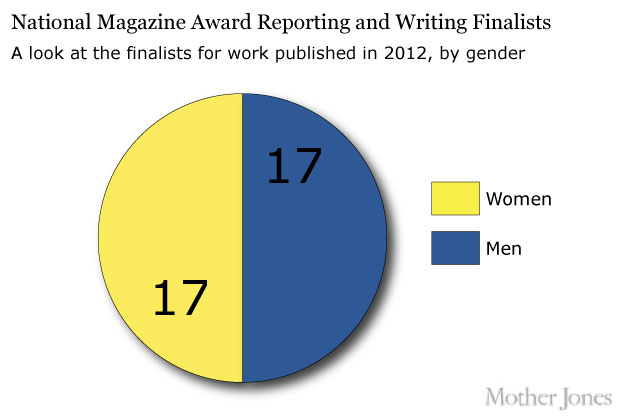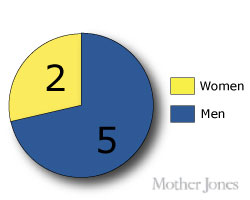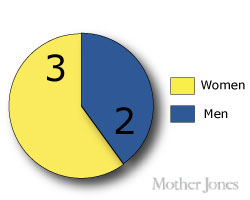
Every year, when the National Magazine Award nominees are announced, there are some gnashed teeth and bitter feelings over what was—and wasn’t—nominated. (We got four [!!] nominations this year, so we’re very happy, if slightly confused.*) But over the last few years, there’s been outrage over one topic in particular: how few women writers are nominated, much less ultimately awarded the “Ellie,” for their work. Was this purely a result of the lack of female bylines in prominent magazines (as pointed out over the years by groups like WomenTK and VIDA)? Was it made worse by magazines not putting women’s work up for nominations? Was it judging bias?
Monika and I wrote about this last year, and in our opinion, it’s mostly the first. But in any case, whether by chance or by collective soul searching, this year has seen dramatic improvement within the reporting and writing categories (public interest, reporting, feature writing, essays and criticism, columns and commentary, and fiction). Last year, women were only nominated for seven of the available 25 slots, and were completely shut out of four categories. This year, they’ve garnered 17 of the available 34 spots, and women are nominees in every category. (Note: There are many other awards given at the National Magazine Awards, including ones to which bylines are attached, like personal service writing. But these are the categories most under debate when it comes to byline parity.)
So how do things break down?

Public Interest: This category basically honors investigative and/or “impact” journalism. Last year it was the lone nonfiction bright spot for women, who comprised four of the five nominees. (Sarah Stillman, also up for an award this year, ultimately won.) This year, the ladies swept the category.*
- The Atlantic for “The Writing Revolution,” by Peg Tyre; October
- Consumer Reports for “Arsenic in Your Juice,” January, and “Arsenic in Your Food,” November, by Andrea Rock
- The New Yorker for “The Throwaways,” by Sarah Stillman; September 3
- Rolling Stone for “School of Hate,” by Sabrina Rubin Erdely; February 16
- Texas Monthly for “Mothers, Daughters, Sisters, Wives,” by Mimi Swartz; August

Reporting: Last year, there were no female nominees in this category (since expanded from five to seven, to account for the fact that there is no longer a profile category). This year two of the seven are women: Texas Monthly‘s Pam Colloff and the Texas Observer‘s Melissa del Bosque.
- Chicago for “Lawbreakers, Lawmakers,” by David Bernstein and Noah Isackson; January
- GQ for “18 Tigers, 17 Lions, 8 Bears, 3 Cougars, 2 Wolves, 1 Baboon, 1 Macaque and 1 Man Dead in Ohio,” by Chris Heath; March
- Harper’s Magazine for “All Politics Is Local: Election Night in Peru’s Largest Prison,” by Daniel Alarcón; February
- The New York Times Magazine for “Did You Think About the Six People You Executed?” by Robert F. Worth; May 13
- The New Yorker for “The Implosion,” February 27, and “The War Within,” August 27, by Jon Lee Anderson
- Texas Monthly for “Hannah and Andrew,” by Pamela Colloff; January
- The Texas Observer for “Valley of Death,” by Melissa del Bosque; March

Feature Writing: This is the “high points for style” category (also expanded this year). Last year, zero women. This year, three: MoJo‘s Mac McClelland as well as Texas Monthly’s Pam Coloff (again!) and Karen Russell in GQ.
- Byliner for “The Living and the Dead,” by Brian Mockenhaupt; October
- GQ for “The Blind Faith of the One-Eyed Matador,” by Karen Russell; October
- GQ for “Burning Man,” by Jay Kirk; February
- Mother Jones for “Shelf Lives,” by Mac McClelland; March/April
- The New Yorker for “Atonement,” by Dexter Filkins; October 29 & November 5
- Texas Monthly for “The Innocent Man: Part I,” November, and “The Innocent Man: Part II,” December, by Pamela Colloff
- Wired for “Inside the Mansion—and the Mind—of Kim Dotcom, the Most Wanted Man on the Internet,” by Charles Graeber; November

Essays and Criticism: Last year, zero women. This year, one: Mona Eltahawy in Foreign Policy.
- The Atlantic for “Fear of a Black President,” by Ta-Nehisi Coates; September
- Foreign Policy for “Why Do They Hate Us?” by Mona Eltahawy; May/June
- New York for “A Life Worth Ending,” by Michael Wolff; May 28
- The New Yorker for “Over the Wall,” by Roger Angell; November 19
- Orion for “State of the Species,” by Charles C. Mann; November/December

Columns and Commentary: Last year, zip. This year, three of five nominees are women: Daphne Merkin in Elle, The Nation‘s Katha Pollitt, and Slate‘s Dahlia Lithwick.
- Elle for three columns by Daphne Merkin: “Portrait of a Lady,” March; “Social Animal,” May; and “We’re All Helmut Newton Now,” October
- The Nation for three columns by Katha Pollitt: “Protect Pregnant Women: Free Bei Bei Shuai,” March 26; “Ann Romney, Working Woman?” May 7; and “Blasphemy Is Good for You,” October 15
- New York for three columns by Frank Rich: “Who in God’s Name Is Mitt Romney?” February 6; “Mayberry R.I.P.,” July 30; and “Nora’s Secret,” August 27-September 3
- The New York Times Magazine for three columns by Adam Davidson: “It Ain’t Just Pickles,” February 19; “The $200,000-Nanny Club,” March 25; and “Caymans, Here We Come,” July 29
- Slate for three columns by Dahlia Lithwick: “It’s Not About the Law, Stupid,” March 22; “The Supreme Court’s Dark Vision of Freedom,” March 27; and “Where Is the Liberal Outrage?” July 6

Fiction: Last year there were three women nominated (Karen Russell for Zoetrope eventually won). This year, three women have been again nominated: Jennifer Haigh in Byliner, Alice Munro in Harper’s, Sarah Frisch in The Paris Review.
- Byliner for “The Boy Vanishes,” by Jennifer Haigh; July
- Harper’s Magazine for “Batman and Robin Have an Altercation,” by Stephen King; September
- Harper’s Magazine for “Train,” by Alice Munro; April
- McSweeney’s Quarterly for “River Camp,” by Thomas McGuane; September
- The Paris Review for “Housebreaking,” by Sarah Frisch; December
The winners will be announced at the awards ceremony on May 2. May the best women—and men!—win.
*We confess to a little befuddlement as to why David Corn’s 47 Percent reporting didn’t get a public interest nomination, but the video itself got a nomination. But then the awards are evolving to figure out how to honor work that’s not a traditional magazine piece.
Note: Thanks to Dana Liebelson for helping whip up these charts. She’ll be on this list one day.















